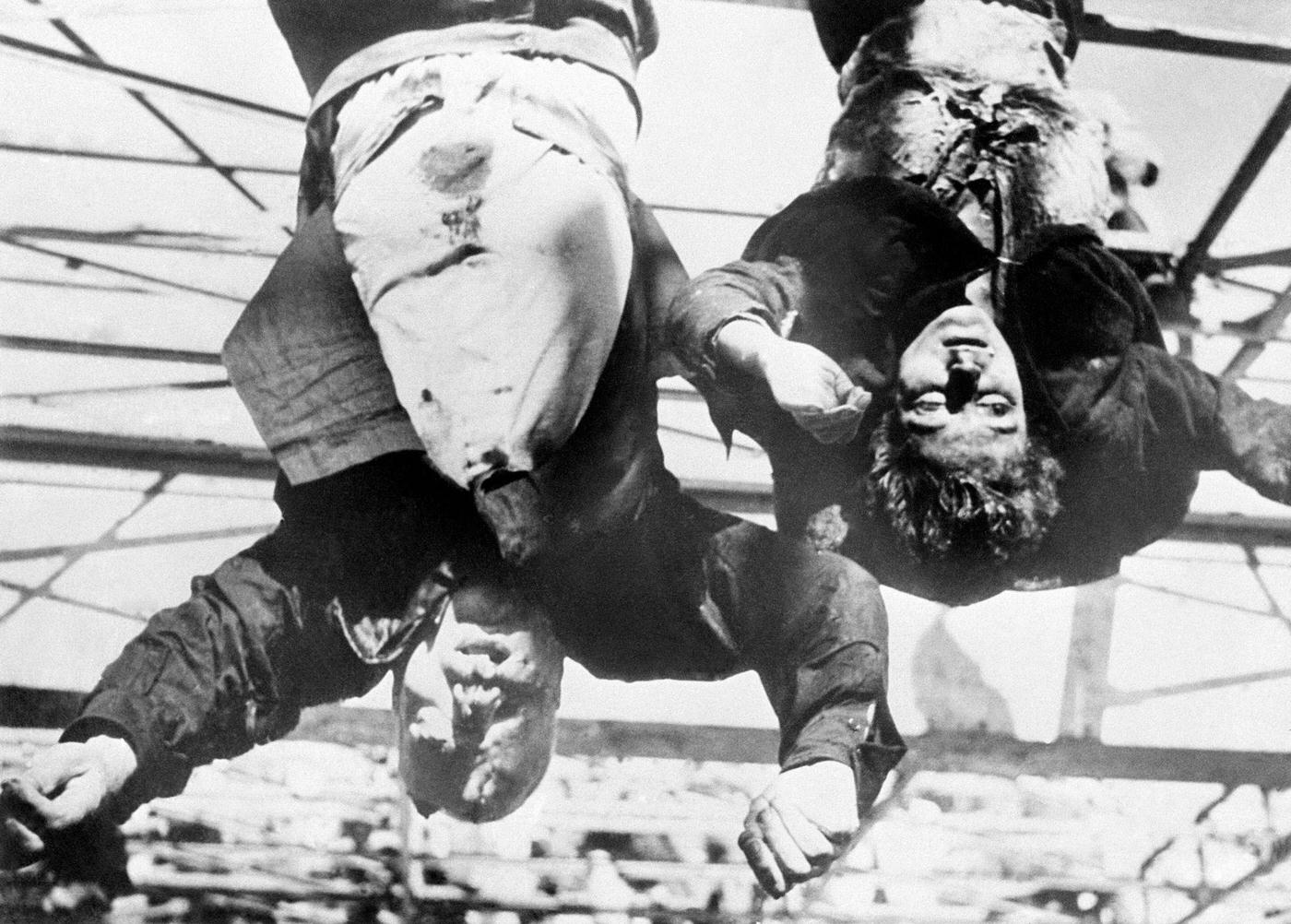The image of the dead bodies of Benito Mussolini, his mistress Claretta Petacci, and other executed fascists on display in Milan in 1945 shocked the world. In this post, we will delve into the events leading up to this grim exhibition, the execution itself, and the aftermath of these events, unraveling the historical context that gave rise to this somber moment.
Background
Benito Mussolini, the founder of Italian Fascism, rose to power in 1922, defining a new era for Italy. His leadership saw the forging of significant alliances, most notably with Nazi Germany and Imperial Japan, during World War II. These partnerships shaped Italy’s military and political stance throughout the conflict. As the war progressed, the tide began to turn against the Axis powers, with the Allied forces making significant advancements. In Italy, this shift in momentum was accompanied by a change in public sentiment, with growing opposition to the Fascist regime. Increasingly isolated and under pressure, Mussolini was eventually arrested, and the Fascist government was overthrown in 1943. This marked the end of an era in Italian politics and set the stage for the complex events that would follow, including Mussolini’s capture, execution, and the subsequent handling of his remains.
Capture and Execution
After his arrest, Mussolini was held in several locations. In April 1945, as the Allies continued to advance through Italy, Mussolini attempted to escape to Switzerland with Claretta Petacci, and other key members of his government. They were captured by Italian partisans near Lake Como and executed on April 28, 1945, along with other prominent Fascists.
The execution was carried out without a formal trial, reflecting the intense emotions and chaos of the time. The group responsible for the capture and execution was the National Liberation Committee, a partisan organization dedicated to fighting Fascism in Italy.
Display in Milan
The bodies of Mussolini, Petacci, and other executed Fascists were brought to Milan, where they were put on public display. The decision to exhibit the corpses was a symbol of the end of Fascism and a way to confirm Mussolini’s death to the Italian people.
The bodies were hung upside down at the Piazzale Loreto, a public square in Milan. This was a deliberate and symbolic act, as the square had been the site of the execution of 15 anti-Fascist partisans the previous year by the Fascist authorities. This gruesome display was meant to send a strong message to the Italian populace and to symbolize the end of the fascist era in Italy.
The display of the bodies lasted for a short period before they were taken down. Thousands of people came to see the grim spectacle, some expressing satisfaction and relief that a dark chapter in Italian history was closed, while others were shocked and disturbed by the macabre scene.
Discovery and Recapture
After the execution of Benito Mussolini and the public display of his body in Milan, his remains became an issue of deep concern for the newly established Italian democracy. The body was on the loose for several months, creating significant anxiety. There were fears that the remains could become a rallying point for those who still harbored loyalty to the Fascist cause.
In August of the same year, the corpse was finally “recaptured” at the Certosa di Pavia, a historic monastery just outside Milan. The body was discovered hidden inside a small trunk, concealed by two Franciscan brothers, who were later charged with hiding the corpse.
Constant Movement
Upon further investigation, authorities found that Mussolini’s body had been constantly on the move. This continual movement likely involved various people, reflecting both the continued support for Mussolini among some and the new government’s difficulty in deciding what should be done with the remains.
The body’s constant relocation demonstrated the underlying tensions still present in Italian society, with lingering divisions between Fascist sympathizers and the advocates of the new democratic order.
Unsure of the appropriate course of action, the authorities held Mussolini’s remains in a kind of political limbo for ten years. This period saw considerable debate and uncertainty, reflecting broader struggles over Italy’s political direction and the legacy of the Fascist era.
Reinterment at Predappio
The government decided to reinter Mussolini’s remains at his birthplace, Predappio in Romagna, considering the political circumstances at that time. The then-current prime minister, Adone Zoli, needed support from the far-right in parliament. To secure this support, he reached out to Donna Rachele, Mussolini’s widow, and told her he was returning the remains. His actions demonstrate how even the handling of Mussolini’s body played a role in the complex political landscape of post-war Italy.
Mussolini’s Tomb
In Predappio, the dictator was buried in a crypt, the only posthumous honor granted to him. His tomb is a place of significant symbolism, flanked by marble fasces – a symbol associated with Fascism – and dominated by a large, idealized marble bust of Mussolini above the tomb. The burial site has since become a place of pilgrimage for some who admire Mussolini, reflecting the continued complexities of his legacy.





















who wanna play some Doom?
He’s never looked better.
Would be interesting to see hitler dangling like this
That’s why he decided to take his own life, so that he could avoid such a fate
Too bad that escaped it.
We don’t have hitler but we have Natanyahu
gbar.
Deutsch
Englisch
perverse aufgeilung an toten
perverse pleasure from dead people